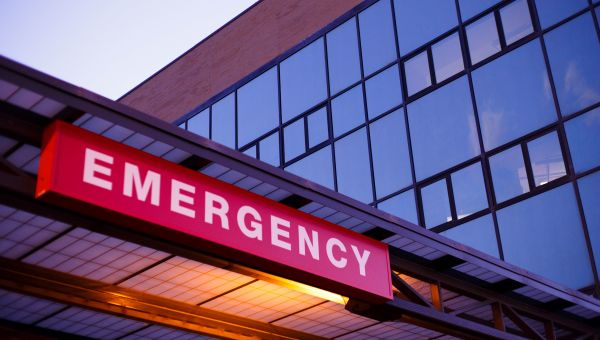Running a Fever? Need Stitches? Here's When to Go to Urgent Care vs. the ER
If your injury or illness isn't a true emergency, walk-in clinics can provide fast, professional and affordable treatment.

The emergency room (ER) is critical when you need immediate treatment for a life-threatening situation. But what about those other times—like an ankle sprain or a suspicious rash—when your ailment or injury isn't dire, but still requires prompt attention? That's where urgent care comes in.
"Urgent care's scope of service is for minor, moderate illnesses and injuries that are not life-threatening," says Michael Kaplan, MD, a family doctor at CareNow in Montgomery, Texas. "The value we bring to the healthcare industry is fast, efficient, professional clinical care."
Patients can go to one of more than 7,600 urgent care facilities in the US when they don't have access to their general practitioner, when they're visiting from out of town or simply, when it's more convenient. You don't usually need an appointment, and compared to the ER, urgent care can be significantly cheaper and much quicker. Facilities provide simple lab tests and can refer patients to emergency care or another provider if more extensive testing is necessary.
What types of injuries are treated at urgent care? From burns to broken bones, here's what you should know.

Cuts
Whether you've slashed your thumb cutting through a bagel or sliced your foot on broken glass, urgent care can treat most wounds requiring more than a bandage and antibiotic ointment. "The majority of folks that walk into our clinic that need stitches—we're going to repair them," says Kaplan.
Wide gashes, wounds with jagged edges or cuts that rip through the skin entirely are good candidates for urgent care. Lacerations that are red, swollen and painful to the touch—signs of infection—can also be examined there.
More severe wounds, including cuts that bleed heavily, very deep gashes that reveal muscle, fat or bone and lacerations on sensitive areas—think face, neck and genitalia—will likely need emergency care. Surgical repair requiring sedation is also beyond what an urgent care facility can typically handle, Kaplan adds.

Fever
Fevers are more dangerous for some age groups than others. If your child is 3 months old or younger and running a rectal temperature of at least 100.4°F, phone your pediatrician or hightail it to the ER. Fevers in newborns can indicate serious health issues and should be treated as quickly as possible.
High temperatures in adults that are accompanied by a headache and stiff neck or a rash need emergency treatment, too. Still, many fevers and fever-triggering illnesses, including sinus infections, upper respiratory tract infections and the flu, can be addressed at urgent care. Health providers at these centers can also administer flu shots.
Certain flu symptoms, however, need emergency care. Go directly to the ER if you:
- Have breathing problems
- Are suddenly dizzy or confused
- Vomit persistently
- Feel pain in your abdomen or chest
- Have flu symptoms that get better, but come back with a bad cough and high fever
In certain situations—like illnesses in older adults or those with a compromised immune system—an urgent care doctor may examine the patient and refer them to emergency care. "We base it on clinical guidelines, your experience as a physician and the presentation of the patient," says Kaplan. "Maybe they have bad pneumonia, they're 80 years old, they're dehydrated and they just look too weak to be treated at home—those folks are transferred to the emergency room."

Burns
When it comes to treating burns, factors including location, depth and the percentage of the body covered help determine care, says Kaplan. Mild or moderate burns, also known as first- or second-degree burns, are typically reddish, swollen and may involve blisters, and can be treated at urgent care.
"Most of the burns we see are from spilled coffee or people touching their exhaust pipe," he adds. Severe sunburns are also good contenders for an urgent care visit.
More serious burns, and those involving hands, feet, face or genitalia, aren’t typically treated at urgent care, Kaplan says. "Those kinds of areas require a little more management." People with deep or severe burns, or burns spanning a significant area of their body—the size of your palm or larger—should dial 911 or head directly to the ER.

Sprains, strains and breaks
Twist your ankle carrying groceries to the car? Urgent care can (usually) handle that. "Most strains or sprains could be seen and treated in an urgent care setting," says Kaplan.
Depending on the location of the injury and the cause, the urgent care physician may recommend an x-ray in addition to a physical exam. After that, doctors may stabilize the injury with a splint or ace bandage, and prescribe rest, ice, compression, elevation—and ibuprofen.
Urgent care can also handle many bone breaks, including wrist, ankle, finger and toe fractures. Many factures that don't include multiple fragments or parts piercing through the skin can be treated, Kaplan suggests. After it's splinted, you would typically be referred to an orthopedic specialist for follow-up care.
It's the more serious fractures that need ER treatment, including breaks where:
- Pain is triggered by very little movement or light pressure
- The bone is broken in multiple pieces
- Bone pierces your skin
- Your joint or limb seems deformed or oddly angled
- At the end of a broken arm or leg, a finger or toe is numb, or blue at the very tip
Hip fractures and other leg breaks also need emergency room care. "Femur fractures typically require higher level of care because there can be a lot of bleeding," says Kaplan.

Vomiting and diarrhea
Most bouts of diarrhea and the stomach bug go away on their own, but if you're becoming best friends with your bathroom, you might consider a trip to urgent care.
"Most of the cases we treat for vomiting or diarrhea are acute viral illnesses related to rotavirus or other types of viral illnesses," says Kaplan. Urgent care doctors can examine you, provide necessary medications and send you home to rest up and hydrate.
If your exam reveals signs of a more serious illness, like appendicitis or diverticulitis, you'll likely be sent to the ER for an additional evaluation. Blood in your vomit or stool is another red flag that something more is wrong, and urgent care doctors can help evaluate that, as well.
If vomiting or diarrhea won't stop, or you're passing a large amount of blood, go to the emergency department immediately.

Skin problems
Some of the most common ailments treated at urgent care are skin-related—especially rashes. "We see contact dermatitis, rashes from shingles, childhood rashes from different viruses and rashes from plants, chemicals and metals," says Kaplan.
Summertime is peak season for poison ivy and poison oak, along with a range of itchy, bumpy bug bites. In many parts of the country, urgent care doctors are experts at diagnosing Lyme disease, as well.
If rashes come with signs of severe illness, like a high fever with a headache or stiff neck, go to the emergency room. Otherwise, most don't require an ER trip, and many respond to basic treatment—oral or topical—or resolve on their own, says Kaplan. Some may need a visit to a dermatologist. As with any urgent care-treated illness or injury, he recommends following up with a primary care doctor.

When to call 911
In addition to severe burns, deep cuts and diarrhea that just won't quit, some other events and symptoms also require a trip to the ER. Skip the urgent care center and get immediate emergency attention for:
- Chest pain, particularly if it's accompanied by arm or jaw pain, and especially in a patient with heart disease risk factors
- Severe abdominal pain or sudden, severe pain anywhere else on your body
- Sudden loss of the ability to move, talk or see
- Sudden drooping on half of your face or body
- Serious allergic reactions
- Trouble or cessation of breathing
- Sudden confusion or loss of consciousness
- Sudden, severe or unusual headaches
- Head injuries, especially those where you lose consciousness
- Spine or neck injuries, especially if you lose feeling or movement
- Seizures
- Drug overdose
- Poisoning or smoke inhalation
Call 911 immediately if you experience any of these troublesome signs; they could signal a serious problem, like heart attack, stroke or cardiac arrest.
Sometimes, a trip to the ER is necessary, and in that case, don't hesitate to head there. Other times, an urgent care facility can get you the help you need—quickly and with minimal costs.
More On


video

article

slideshow


video


video
